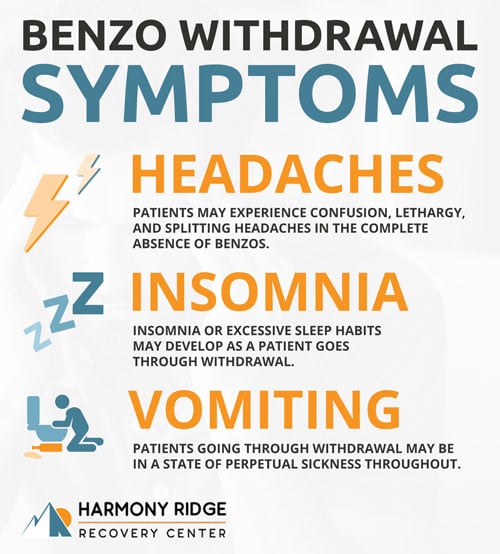From 1996 to 2013, the number of people filling benzodiazepine prescriptions increased by over 60%. Benzodiazepines (benzos) are a group of central nervous system depressants used to treat anxiety, insomnia, and seizures. Types of benzodiazepines include Xanax, Klonopin, Valium, and Onfi.
These drugs produce feelings of calmness and euphoria, but they can also cause the opposite. They can lead to vivid or disturbing dreams, anterograde amnesia, hostility, and irritability. Benzos can be highly addictive and benzo withdrawal may be difficult to handle on your own. Addiction treatment centers will follow a benzo taper schedule to avoid any unpleasant withdrawal symptoms.
After taking high doses of benzos for a long period of time, individuals with substance use disorders can develop a tolerance to benzos. When individuals are dependent on benzos, their bodies don’t know what to do without the drug. Then, when such individuals want to stop taking benzos, withdrawal symptoms are likely to occur—unless they find a facility that understands the importance of tapering benzodiazepines.
Using a Benzo Taper Schedule To Ease Withdrawal Symptoms

When individuals have been taking benzos for two weeks or longer, it’s recommended that they consider a benzo taper. It’s not recommended to stop abruptly. People who quit benzos without a taper may experience a life-threatening grand-mal seizure. To taper off means to take progressively smaller doses over the course of a few weeks or months. Although this may seem like a big step, tapering is a necessary step toward recovery.
Common Benzo Taper Schedule
The American Addictions Center (AAC) suggests an initial reduction of benzos by 25-30% for high dosage chronic users, followed by a 5-10% daily to weekly reduced dose.
A 25% weekly reduction is recommended for individuals who normally take therapeutic doses at bedtime. For those who take therapeutic doses during the daytime, an initial dose reduction of 10-25% should be implemented, followed by further reductions of 10-25% every 1-2 weeks thereafter.
This benzo taper guideline is particularly effective for individuals with post-traumatic stress disorder (PTSD) who may use benzos to help them manage any emotional trauma. However, there are other benzo taper guidelines doctors may use, as well.
The Ashton Method as a Benzo Taper Guideline
The Ashton Method was developed by Dr. Ashton, a physician in England. This method allows the body and the brain to adjust to the brain chemistry change when stopping benzo use. Although tapering off benzos is not pleasant, patients have found that The Ashton Method is very tolerable compared to other options.
The Ashton Method has reported a 90% success rate. This method’s protocol recommends using diazepam to taper, as the benefits of a long half-life are important for tapering. Diazepam’s half-life of up to 200 hours means it can help to prevent secondary issues, like interdose withdrawal (withdrawal symptoms that develop between doses), that can lead to major problems during cessation. Diazepam also comes in smaller doses.
There are other types of medications that may be used to ease benzo withdrawal symptoms. Clonazepam, another type of benzo, has a medium half-life. Alprazolam has a short half-life. It’s up to the discretion of the medical professional to decide on what he or she will administer.
Why It’s Important To Follow Benzodiazepine Taper Guidelines
Benzos affect the GABA receptors, a neurotransmitter that sends chemical messages through the brain and the nervous system and is involved in regulating communication between brain cells. Since benzos impede these receptors from functioning properly, it slows down the body’s systems. The brain becomes accustomed to this influx of GABA and attempts to adapt. Stopping abruptly can cause the body and brain to react violently as a result.
A benzo taper can take two to three weeks for some patients and several months for others. When tapering off benzos, people may still experience some symptoms of withdrawal after each dose reduction.
Addiction Treatment Centers Can Help With a Benzo Taper
When a person wishes to stop taking benzos, it’s important that the process is done at a specialized drug treatment facility where medical and mental health professionals are on hand to offer direct support and care, like Harmony Ridge Recovery Center. Substance abuse treatment can help a person sustain abstinence from benzodiazepines in the long run.
It’s important to note that there is no “one size fits all” solution for people tapering off of benzos. Doctors can make a personalized tapering schedule. This will be based on one’s current dose and particular circumstances.
What To Know About Benzo Withdrawal
Understanding how to taper off benzos doesn’t illuminate the severity of benzo withdrawal symptoms. Benzos are known to have among the most dangerous withdrawals of any drug. According to American Addiction Centers (AAC), drug withdrawal may include a combination of physical, mental, and emotional symptoms — some of which can prove dangerous if left unmanaged.
The first signs of benzo withdrawal usually starts within six to eight hours for shorter-acting benzos (Xanax, Dormonoct, Halcion) and 24 to 48 hours of longer-acting benzos (Valium, Klonopin, Librium).
The severity of withdrawal symptoms is associated with a variety of factors, including current dose, how long a person has been taking it, whether someone takes other sedating drugs, and so much more.
Common Benzo Withdrawal Symptoms

- Headaches – Patients may experience splitting headaches in the complete absence of benzos.
- Sleep disturbances – Insomnia or excessive sleep habits may develop as a patient goes through withdrawal.
- Irritability – Agitation and rude behavior are common occurrences, especially when the patient’s cravings are hitting their hardest.
- Convulsions – Erratic actions and movements can result from disrupted brain chemical signals.
- Tremors – Involuntary movements may manifest in various areas of the body, particularly in the hands.
- Nausea and vomiting – Patients going through withdrawal may be in a state of perpetual sickness throughout.
- Psychosocial episodes (severe panic attacks, psychosis, hallucinations, and seizures) – A patient’s central nervous system will be attempting to self-correct after substance interference. In turn, neurological incidents may result.
- Delirium – Characterized by auditory, tactile, and visual hallucinations. It can also cause disturbances in consciousness and cognition, which can lead to erratic behavior as well as possible accidents.
Rebound Effects vs. Benzo Withdrawal
Rebound symptoms usually occur within one to four days of discontinuing benzo use without a proper tapering method. This depends on the type of benzo used, the dosage, and the frequency of use.
Rebound effects are the return of previous symptoms (anxiety, panic attacks, depression, etc.) that were in existence before the patient started using benzos. Withdrawal symptoms are caused by the body struggling to adapt to the end of benzos use.
Those experiencing anxiety while tapering off benzos should have a backup plan. Cognitive-behavioral therapy (CBT), meditation, mindfulness training, and exercise may help.
Post-Acute Withdrawal Symptoms
Post-acute withdrawal symptoms may continue to occur after people suffering from substance use disorders stop using benzos. Post-acute withdrawal symptoms can occur for six months or longer. Symptoms include persistent anxiety, chronic insomnia, difficulty performing complex tasks, poor concentration, loss of sex drive, and depression. Psychological withdrawal symptoms may also continue for months, but they can be controlled and minimized with proper professional help.
What To Do After Tapering Benzodiazepines

Treatment for Benzo Addiction
Those taking the first step to free themselves from a substance use disorder will need to taper off benzodiazepines through a detox program. Afterward, they have the option to go to inpatient or outpatient treatment. The main difference between the two programs is that inpatient treatment requires patients to stay at the addiction treatment facility while outpatient care doesn’t.
Inpatient Programs
A benzo addiction is not to be taken lightly. With this in mind, it’s best to join an inpatient treatment program where patients are under 24/7 care and are constantly surrounded by peers all working toward sobriety. There are standard inpatient programs that are rigid and structured while residential inpatient programs are a bit laxer.
Outpatient Programs
Alternatively, there are outpatient programs that may benefit those who don’t have the ability to live in an addiction treatment center while working toward recovery. In this case, they may opt to choose between a partial hospitalization program (PHP), an intensive outpatient program (IOP), or a standard outpatient program.
A PHP requires the most time while an IOP requires less time, but is still quite rigorous. Standard outpatient programs require only a few hours a week and are only truly beneficial to those who are taking a step down from a more intensive program. Standard outpatient treatment would be a good part of an aftercare plan.
Aftercare Plan
It may seem hard to stay sober when leaving inpatient treatment for a benzo withdrawal. Those just leaving inpatient treatment may find themselves put in triggering situations, or situations that spark the thought of reverting back to old habits. There are a few actions to take to avoid or manage these temptations, including:
- Finding a solid, sober support system. When people surround themselves with sober people who have their best interests at heart, they will have a sense of community. If such people are not sure who to turn to, they should try looking for a support group in their area.
- Modifying the environment. Before someone leaves treatment, he or she should ask a loved one to remove anything triggering from his or her home. This will prevent a trigger before it happens.
- Setting goals for the future. When people in recovery look towards the future and set goals, they will be able to manage their temptations when they arise. People in recovery must remember why they want to stay sober and all the benefits it will bring to their life.
- Keeping follow-up appointments. It’s important to schedule follow-up appointments with a doctor to ensure one is staying on the right track after completing rehab. It’s easy to think that people in recovery can handle things on their own. As a result, though, individuals may be tempted to skip appointments. Still, it’s much easier to handle temptations when getting help from health professionals.
- Finding moments each day to be thankful. Whether individuals write down their gratitude in a journal or just think about what they are thankful for every day, they will reap the benefits. When individuals have a strong appreciation for the life they have been given, it is easier to recognize how much they have to be thankful for.
- Creating new, healthy habits to replace old ones. Keep pushing forward. It’s important to find some new and enjoyable activities. Those in recovery should find something that they like doing and stick with it. Exercising, meditating, and volunteering can all take up time in positive ways.
Taper Off Benzos In a Safe, Peaceful Environment
Benzos are one of the most commonly prescribed medications in the country. If you or a loved one is addicted to benzos, help is available. With proper care and follow-up support, recovery can be achieved.
Addiction treatment will help you or your loved one improve coping skills and rectify behaviors that influence drug use. Without the right treatment, withdrawal from benzos can be extremely dangerous. We are here to help, so please don’t hesitate to contact us today.



